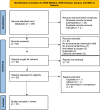Interventions to achieve environmentally sustainable operating theatres: an umbrella systematic review using the behaviour change wheel
- PMID: 39093843
- PMCID: PMC11573083
- DOI: 10.1097/JS9.0000000000001951
Interventions to achieve environmentally sustainable operating theatres: an umbrella systematic review using the behaviour change wheel
Abstract
Introduction: The healthcare sector is a major contributor to the climate crisis and operating theatres (OTs) are one of the highest sources of emissions. To inform emissions reduction, this study aimed to (i) compare the outcomes of interventions targeting sustainable behaviours in OTs using the Triple Bottom Line framework, (ii) categorise the intervention strategies using the five Rs (reduce, recycle, reuse, refuse, and renew) of circular economy, and (iii) examine intervention functions (IFs) using the Behaviour Change Wheel (BCW).
Methods: Medline, Embase, PsychInfo, Scopus, and Web of Science databases were searched until June 2023 using the concepts: sustainability and surgery. The review was conducted in line with the Cochrane and Joanna Briggs Institution's recommendations and was registered on PROSPERO. The results were reported in line with Preferred Reporting Items for Systematic reviews and Meta-Analyses (PRISMA) (Supplemental Digital Content 1, http://links.lww.com/JS9/D210 ) guidelines.
Results: Sixteen reviews encompassing 43 life-cycle analyses, 30 interventions, 5 IFs, and 9 BCW policy categories were included. 28/30 (93%) interventions successfully led to sustainability improvements; however, the environmental outcomes were not suitable for meaningful comparisons due to their using different metrics and dependence on local factors. The 'reduce' strategy was the most prolific and commonly achieved through 'education' and/or 'environmental restructuring'. However, single-session educational interventions were ineffective. Improving recycling relied on 'environmental restructuring'. More intensive strategies such as 'reuse' require multiple intervention functions to achieve, either through a sustainability committee or through an intervention package.
Conclusion: Policymakers must examine interventions within the local context. Comparing the outcomes of different interventions is difficult and could potentially be misleading, highlighting the need for a tool integrating diverse outcomes and contextual factors. 'Reduce' strategy guarantees environmental and financial savings, and can be achieved through 'Education' and/or 'environmental restructuring'.
Copyright © 2024 The Author(s). Published by Wolters Kluwer Health, Inc.
Conflict of interest statement
The authors declare that the research was conducted in the absence of any commercial or financial relationships that could be construed as a potential conflict of interest.
Figures



References
-
- Costello A, Abbas M, Allen A, et al. . Managing the health effects of climate change: Lancet and University College London Institute for Global Health Commission. The Lancet 2009;373:1693–1733. - PubMed
-
- Watts N, Adger WN, Agnolucci P, et al. . Health and climate change: policy responses to protect public health. The lancet 2015;386:1861–1914. - PubMed
-
- Savaresi A. The Paris agreement: an early assessment. Envtl Pol’y & L 2016;46:14.
-
- Campion N, Thiel CL, Woods NC, et al. . Sustainable healthcare and environmental life-cycle impacts of disposable supplies: a focus on disposable custom packs. J Clean Prod 2015;94:46–55.
-
- Tan E, Lim D. Carbon footprint of dermatologic surgery. Austral J Dermatol 2021;62:e170–e177. - PubMed
Publication types
MeSH terms
Grants and funding
LinkOut - more resources
Full Text Sources

